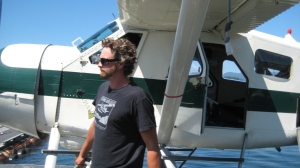There’s an organic caviar farm, Northern Divine (http://www.northerndivine.com) in Sechelt just across the Straits of Georgia from Nanaimo where the conference is located. The best way to make a quick trip across the strait? A little teeny bushplane with floats.
A common feature of BC beaches: lots and lots of driftwood.
Some folks from Northern Divine picked us up from the floatplane dock and brought us over to the facility. They have people come through on tours all the time, so they’ve got windows for easy checking-out of the caviar making process without having to track through and disrupt everybody.
The way traditional caviar harvest works is slaughter the fish, remove the ovaries with the eggs all still attached to the membranes, and then rubbing the mass across a screen to separate the eggs from the membrane. A couple of the guys on our tour have caviar farms of their own, so they were discussing the ins and outs of getting the fish to a nice healthy size without overfeeding to the point that lots of fat accumulates on and in the ovarian tissue– leading to weird flavors and poor yields. One related how at the very beginning of their operation, they knew that caviar yield was about 10% of body weight. They fed the fish as much as they would eat so as to have bigger fish. The end result was about 2% bw worth of caviar and lots and lots of sturgeon grease. Oops….
This is the stretcher where they hold the fish for gutting. Ovaries go in in a container and pass through a window to the caviar room for screening. (They want to keep whole fish separate from the caviar.) Everything else gets filleted.
The most important part of turning eggs into caviar is adding salt. Like most things, sturgeon eggs release liquid when they encounter salt. As the volume shrinks you need to press on the tin to shrink it down and get the liquid out. Pretty much the same deal as pressing the whey out of cheese– with the exception that in caviar you’re not trying to fuse individual eggs together the way you do with cheese curds. You want to remove just enough that they’re not gloopy but not so much that they get dry. What did they find out was the perfect size & shape for getting the job done? Kettle bells.
Stay tuned for more ISS7 caviar loveliness all this week!







